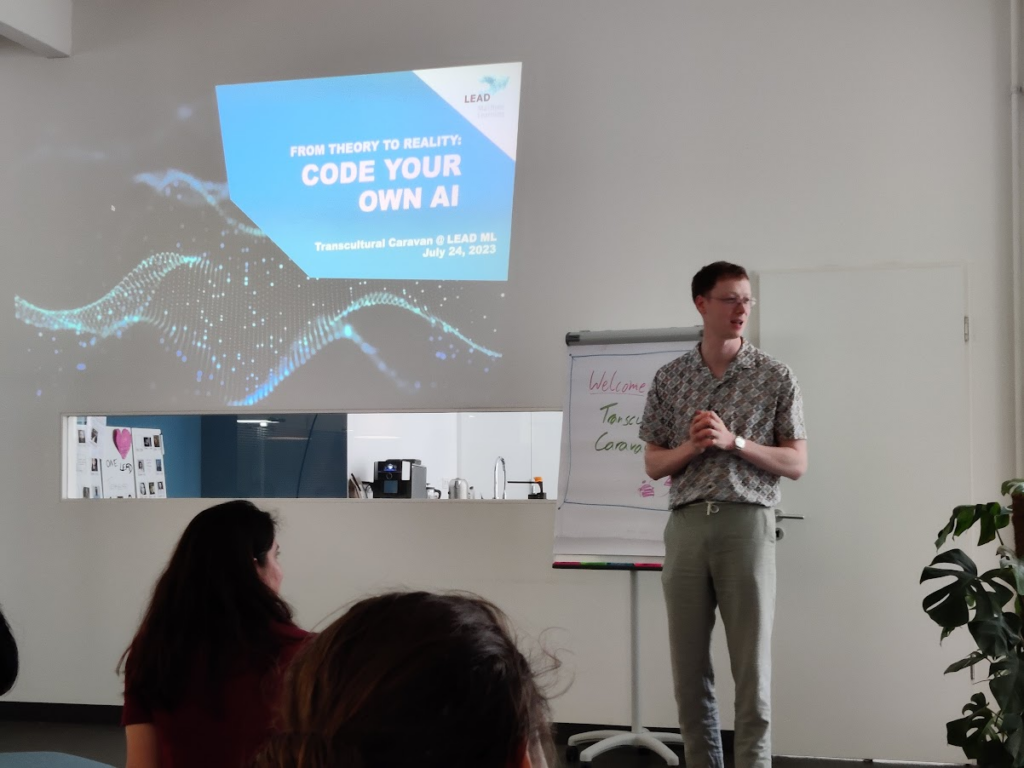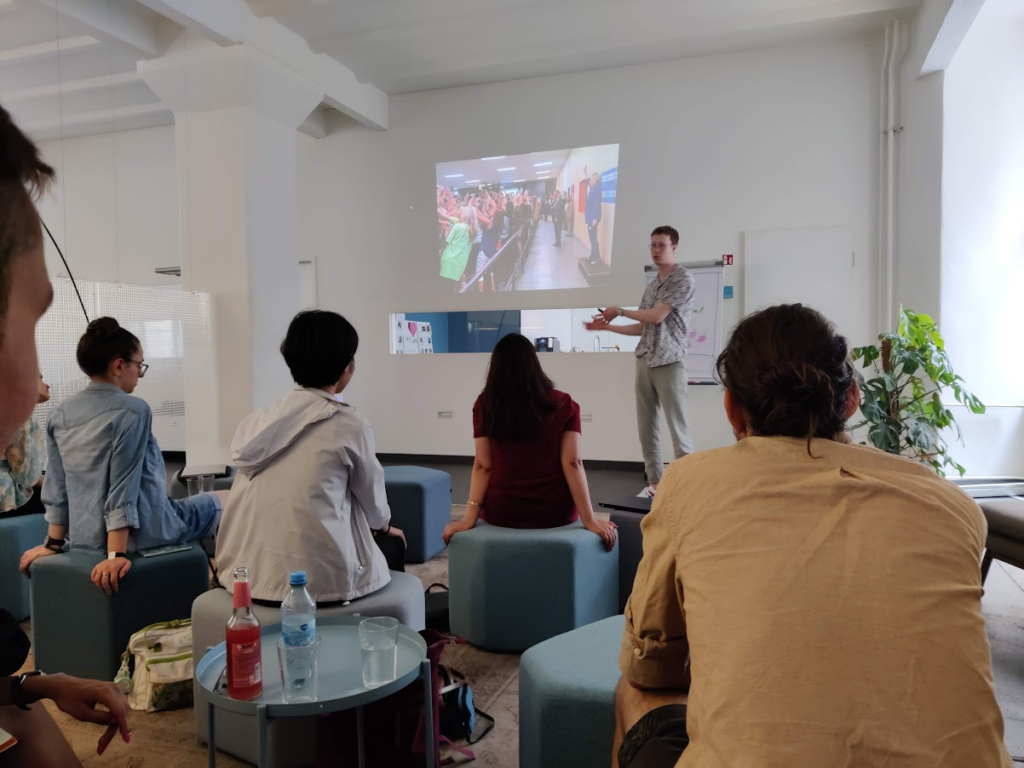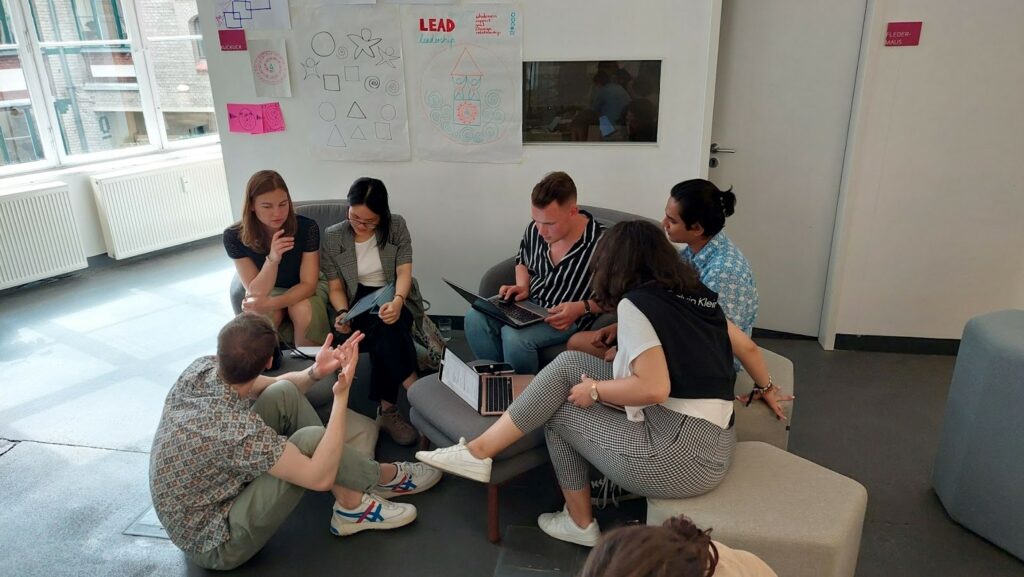By Ngoc Doan Minh & Luca Fioretti
Being a transcultural leader is a challenging job. Besides dealing with multilateral problems, leading transculturally also involves staying up to date and making guidelines for all changes that might occur in the world.

On the first official day of our Transcultural Caravan tour this year, we were privileged to hear the arguments from a first-gen Transcultural Caravan student researcher himself. Tim R. Schleicher – (now the) Founder and CEO of LEAD Machine Learning in Berlin – offered us a very enlightening AI workshop, “From Theory to Reality,” which left us contemplating leadership responsibilities in this modern world.
Understanding Artificial Intelligence (AI)
The emergence of Artificial Intelligence (AI) has provided leaders with tools that could boost productivity and enhance connections in a matter of minutes. However, the access to data and the use of this novel technology is also a matter of urgent concern for transcultural leadership.
Being an ex-student of the Transcultural Caravan and having excellent knowledge of tech, Tim guided us through the fundamental concepts of Artificial Intelligence (AI). AI, originating in the 1950s, is about machines mimicking human intelligence, using Machine Learning (ML), Deep Learning (DL), and Neural Networks to greater levels.
Types of AI and Their Significance
For further specialization, AI is categorized into three groups as below.
A. Narrow AI: Narrow AI is also known as weak AI, and it is programmed to target the performance of only a specific task, such as image and facial recognition and virtual assistants. Some of the most common examples of this niche of AI are Google Translate and Siri by Apple.
B. General AI: General AI is considered to be strong AI capable of any intellectual tasks a human being can perform. Self-driving cars or chatbots such as Chat-GPT are typical examples.
C. Super AI: Super AI is a type of AI technology that outperforms human intelligence and ability. It has the potential to be the best at everything, including mathematics, physics, and medicine. Super AI-enabled bots can even outperform humans in terms of intellectual power. For the time being, it remains a distant reality with untapped promise.
The Role of Data in Transcultural Leadership
After being given some fundamental knowledge, we were asked to watch an interesting video on footballers, which you can access here:
Les actions folles de l’équipe de France qu’on a tous oubliées – Orange
What struck us about that short clip is the power of Artificial Intelligence to change the reality of the entire scene. Particularly, changing the figure and faces of talented female French footballers to their male counterparts. But furthermore, it is the issue of how people tend to classify things into particular boxes that we found the most fascinating and alarming.
Transcultural Leadership in the Era of Data and AI

The picture above shows how we can record data anytime and anywhere we want only with a smartphone. Our smartphone is now not just a tool for calling, messaging, and socializing but also a powerful tool for data collection. This is when the dilemma emerges because people tend to believe that AI will replace many positions, we have in the workplace nowadays. However, as emphasized by Tim:
“AI requires more leadership, not less.”
The total amount and variety of data storage is growing. Who is in charge of deciding what kinds of data should be kept for analysis? Or by whom would the data be gathered? In the modern world, a transcultural leader must be able to see the complexity of having a wealth of information while also knowing how to select and categorize it to prevent any potential human biases.
Practical Experience with AI Coding
A powerful slide was displayed, showing the formula: AI model = Pain x Data. After having looked through some concepts of AI, we went straight forward to its implementation in actual software for developers. The link to our personal coding notebooks was emailed and introduced us to the four main steps to build an AI model:
Insert Data => Build neural networks => Training => Testing.

It was such a thrilling experience jumping around the lines and figuring out how this or that code works. One thing to be sure – it was pretty painful since many of us had never encountered programming before. However, Tim was always patient, passionate, and kind to instruct us through all the necessary steps – which helped us successfully build an AI model that could affix labels to items sold in a clothing store.
Key Takeaways and Inspirations
At first, we observed the world of AI at first hand and looked closely at what it means to write code to make a program work. We learned how difficult and straightforward it can be simultaneously with constant attention to detail and the human inventiveness needed to design the code step by step to get to the initial idea.
We also had a chance to reflect upon the rapid change in the importance of a transcultural leader in this modern world. The governance, access, and usage of data in technological models are among the critical fields to ponder in transcultural leadership.
In short, this workshop was an eye opener for us regarding how technical AI could be, however the application of AI can not only bring efficiency but also can contribute to managing transculturality in the corporate world.
